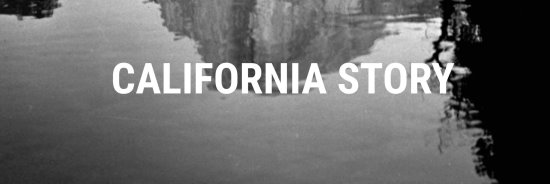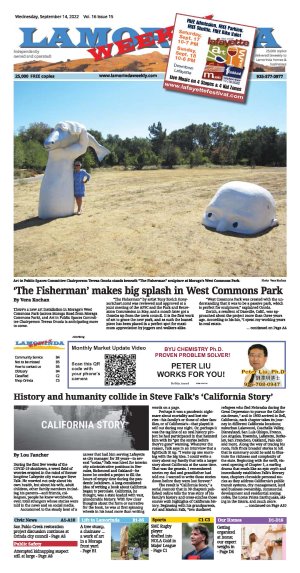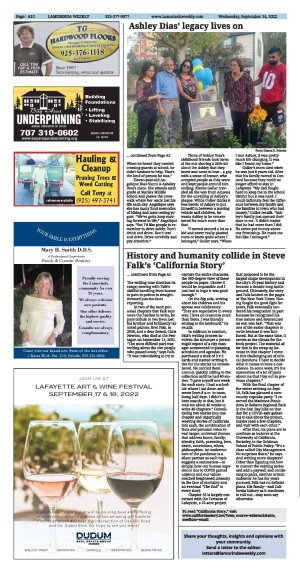| | Published September 14th, 2022
| History and humanity collide in Steve Falk's 'California Story'
| | | By Lou Fancher |  | | |
During the first few weeks of the COVID-19 shutdown, a weed field of worries erupted in the mind of former longtime Lafayette city manager Steve Falk. He worried not only about his own health, but about his wife, adult children, other family members including his parents-and friends, colleagues, people he knew worldwide, even total strangers whose stories were told in the news and on social media.
 Accustomed to the steady beat of a career that had him serving Lafayette as city manager for 28 years-in several "codas," Falk was hired for interim city administrative positions in Hercules, Richmond and Oakland-he knew he needed a project to fill the hours of empty time during the pandemic lockdown. A long-considered idea of writing a book about California began to percolate. California, he thought, was a state loaded with vast, plunderable history. With few clear thoughts about the form or narrative for the book, he was at first spinning wheels in his head more than writing words on a page.
Accustomed to the steady beat of a career that had him serving Lafayette as city manager for 28 years-in several "codas," Falk was hired for interim city administrative positions in Hercules, Richmond and Oakland-he knew he needed a project to fill the hours of empty time during the pandemic lockdown. A long-considered idea of writing a book about California began to percolate. California, he thought, was a state loaded with vast, plunderable history. With few clear thoughts about the form or narrative for the book, he was at first spinning wheels in his head more than writing words on a page.
 Perhaps it was a pandemic nightmare about mortality and lost stories-his family's or those of other families, or of California's-that played itself out during one night. Or, perhaps it was the tag line of an oral history project he had participated in that haunted him with its "get the stories before they're gone" warning. Whatever the reason, Falk says in an interview that a lightbulb lit up. "I woke up one morning with the big idea. I could write a story about my family that tells a larger story about California at the same time. That was the genesis. I remembered stories my dad and grandfather had told me. I wanted to write those stories down before they were lost forever."
Perhaps it was a pandemic nightmare about mortality and lost stories-his family's or those of other families, or of California's-that played itself out during one night. Or, perhaps it was the tag line of an oral history project he had participated in that haunted him with its "get the stories before they're gone" warning. Whatever the reason, Falk says in an interview that a lightbulb lit up. "I woke up one morning with the big idea. I could write a story about my family that tells a larger story about California at the same time. That was the genesis. I remembered stories my dad and grandfather had told me. I wanted to write those stories down before they were lost forever."
 The result is "California Story," a serial memoir that in 39 chapters published online tells?the true story of his family's history and cross-stitches those stories with highlights of California history. Beginning with his grandparents, Art and Marion Falk, "two dustbowl refugees who fled Nebraska during the Great Depression to pursue the California dream," and in 1930 arrived in Bell, California, each chapter takes its journey in different California locations; suburban Lakewood, Coachella Valley, Disneyland, San Luis Obispo, Fresno, Los Angeles, Yosemite, Lafayette, Berkeley, San Francisco, Oakland, Palo Alto and more. Along the way of tracing his roots, Falk finds broader stories to tell that in summary could be said to illustrate the richness and complexity of the state. Beginning with the swift, visceral opening of Chapter 1, a surfing drama that reads like an epic myth and immediately establishes Falk's literary tone, chapters chronicle personal stories as they address California's public transit systems, city management, land and business ownership, commercial development and residential zoning codes, the Loma Prieta Earthquake, skiing in the Sierra, and much more. The writing tone stretches its range; moving with Falk's skillful handling from humor to pain to pathos to straightforward just-the-facts reporting.
The result is "California Story," a serial memoir that in 39 chapters published online tells?the true story of his family's history and cross-stitches those stories with highlights of California history. Beginning with his grandparents, Art and Marion Falk, "two dustbowl refugees who fled Nebraska during the Great Depression to pursue the California dream," and in 1930 arrived in Bell, California, each chapter takes its journey in different California locations; suburban Lakewood, Coachella Valley, Disneyland, San Luis Obispo, Fresno, Los Angeles, Yosemite, Lafayette, Berkeley, San Francisco, Oakland, Palo Alto and more. Along the way of tracing his roots, Falk finds broader stories to tell that in summary could be said to illustrate the richness and complexity of the state. Beginning with the swift, visceral opening of Chapter 1, a surfing drama that reads like an epic myth and immediately establishes Falk's literary tone, chapters chronicle personal stories as they address California's public transit systems, city management, land and business ownership, commercial development and residential zoning codes, the Loma Prieta Earthquake, skiing in the Sierra, and much more. The writing tone stretches its range; moving with Falk's skillful handling from humor to pain to pathos to straightforward just-the-facts reporting.
 In two of the most personal chapters that Falk says were the hardest to write, he pays tribute to two lives lost: his brother and brilliantly talented painter, Bret Falk, in 2006, and a dear friend, Chris Newton, who died at the Pentagon on September 11, 2001. "The most difficult part was writing about the two people who passed away," says Falk. "It was intimidating to try to capture the entire character, the 360-degree view of these people on paper. I knew it would be impossible and I just had to hope it was good enough."
In two of the most personal chapters that Falk says were the hardest to write, he pays tribute to two lives lost: his brother and brilliantly talented painter, Bret Falk, in 2006, and a dear friend, Chris Newton, who died at the Pentagon on September 11, 2001. "The most difficult part was writing about the two people who passed away," says Falk. "It was intimidating to try to capture the entire character, the 360-degree view of these people on paper. I knew it would be impossible and I just had to hope it was good enough."
 On the flip side, writing about his children and his spouse was celebratory. "They are superlative in every way. I love no creatures more than them. I was literally smiling at the keyboard," he recalls.
On the flip side, writing about his children and his spouse was celebratory. "They are superlative in every way. I love no creatures more than them. I was literally smiling at the keyboard," he recalls.
 In addition to emotion, Falk's writing process involved the structure a person might expect of a city manager accustomed to planning, schedules and agendas. He purchased a deck of 3 x 5 cards and started writing titles for the stories he remembered. He carried them around, quickly adding to the collection until he had 40 stories. "I gave myself one week for each story. I had a schedule where I sat down and wrote from 8 a.m. to noon, doing half days. I didn't adhere exactly to that, but it took me about 40 weeks to write 40 chapters." Consolidating two stories into one chapter and organically weaving stories of California into each, the combination of facts and personal voice reveal larger, universal themes that address home, family, identity, faith, parenting, love, death, convictions, ethics, philosophies. An undercurrent of the pandemic is a silent partner as each topic suggests a summation-or simply, how our human experience due to COVID gained urgency and our values reached heightened intensity in the face of mortality and an eventual "The End" to every story.
In addition to emotion, Falk's writing process involved the structure a person might expect of a city manager accustomed to planning, schedules and agendas. He purchased a deck of 3 x 5 cards and started writing titles for the stories he remembered. He carried them around, quickly adding to the collection until he had 40 stories. "I gave myself one week for each story. I had a schedule where I sat down and wrote from 8 a.m. to noon, doing half days. I didn't adhere exactly to that, but it took me about 40 weeks to write 40 chapters." Consolidating two stories into one chapter and organically weaving stories of California into each, the combination of facts and personal voice reveal larger, universal themes that address home, family, identity, faith, parenting, love, death, convictions, ethics, philosophies. An undercurrent of the pandemic is a silent partner as each topic suggests a summation-or simply, how our human experience due to COVID gained urgency and our values reached heightened intensity in the face of mortality and an eventual "The End" to every story.
 Chapter 35 is largely concerned with the Terraces of Lafayette, a 22-acre project that proposed to be the largest single development in the city's 50-year history and became a decade-long battleground. Ultimately, the story and Falk landed on the pages of The New York Times. Having fought the good fight for years, Falk eventually tendered his resignation in part because he recognized his true nature and determined an exit was best. "That was one of the easier chapters to write because it was fact-based. But at the same time, it serves as the climax for the book project. The material after that is the wrap-up because in that chapter I come to this challenging set of ethical decisions. I have to decide what it means to have a conscience. In some ways, it's the summation of a lot of parts about me that I lay out in previous chapters."
Chapter 35 is largely concerned with the Terraces of Lafayette, a 22-acre project that proposed to be the largest single development in the city's 50-year history and became a decade-long battleground. Ultimately, the story and Falk landed on the pages of The New York Times. Having fought the good fight for years, Falk eventually tendered his resignation in part because he recognized his true nature and determined an exit was best. "That was one of the easier chapters to write because it was fact-based. But at the same time, it serves as the climax for the book project. The material after that is the wrap-up because in that chapter I come to this challenging set of ethical decisions. I have to decide what it means to have a conscience. In some ways, it's the summation of a lot of parts about me that I lay out in previous chapters."
 With the final chapter of the series arriving on Sept. 18, Falk has planned a community cupcake party. "I reserved the Madrone Picnic Area in Roberts Regional Park in the East Bay hills on that day for a COVID-safe gathering to talk about the project, maybe read a few chapters, and visit with each other."
With the final chapter of the series arriving on Sept. 18, Falk has planned a community cupcake party. "I reserved the Madrone Picnic Area in Roberts Regional Park in the East Bay hills on that day for a COVID-safe gathering to talk about the project, maybe read a few chapters, and visit with each other."
 After that, his plans are to continue as lecturer at the University of California, Berkeley, in the Goldman School of Public Policy. "It's a class called City Management. No surprises there," he says. And writing more chapters? Other than figuring out how to convert the existing series and add a paywall and continuing to paint, another artistic endeavor he has for years pursued, Falk has no definite plans. His family-and California history as it continues to roll out-may soon say otherwise.
After that, his plans are to continue as lecturer at the University of California, Berkeley, in the Goldman School of Public Policy. "It's a class called City Management. No surprises there," he says. And writing more chapters? Other than figuring out how to convert the existing series and add a paywall and continuing to paint, another artistic endeavor he has for years pursued, Falk has no definite plans. His family-and California history as it continues to roll out-may soon say otherwise.
 To read "California Story," visit www.californiastory.net/?utm_source=substack&utm_medium=email
To read "California Story," visit www.californiastory.net/?utm_source=substack&utm_medium=email |
| | | | | | | | | | | | |




